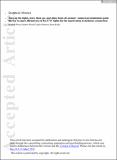Files in this item
Turn up the lights, leave them on, and shine them all around - numerical simulations point the way to more efficient use of Far-UVC lights for the inactivation of airborne coronavirus
Item metadata
| dc.contributor.author | Wood, Kenneth | |
| dc.contributor.author | Wood, Andrew | |
| dc.contributor.author | Peñaloza, Camilo | |
| dc.contributor.author | Eadie, Ewan | |
| dc.date.accessioned | 2022-10-22T23:36:30Z | |
| dc.date.available | 2022-10-22T23:36:30Z | |
| dc.date.issued | 2021-10-23 | |
| dc.identifier | 276152912 | |
| dc.identifier | 487e82af-f052-4d42-8204-e20671322133 | |
| dc.identifier | 85117588490 | |
| dc.identifier | 000710182700001 | |
| dc.identifier.citation | Wood , K , Wood , A , Peñaloza , C & Eadie , E 2021 , ' Turn up the lights, leave them on, and shine them all around - numerical simulations point the way to more efficient use of Far-UVC lights for the inactivation of airborne coronavirus ' , Photochemistry and Photobiology , vol. Early View , 13523 . https://doi.org/10.1111/php.13523 | en |
| dc.identifier.issn | 0031-8655 | |
| dc.identifier.other | RIS: urn:3BD4855C5957CB307752FE0C948A9557 | |
| dc.identifier.uri | https://hdl.handle.net/10023/26231 | |
| dc.description | We acknowledge financial support from the University of St Andrews Restarting Research Funding Scheme (SARRF) which is funded through the Scottish Funding Council grant reference SFC/AN/08/020. | en |
| dc.description.abstract | It has been demonstrated in laboratory environments that ultraviolet-C (UVC) light is effective at inactivating airborne viruses. However, due to multiple parameters, it cannot be assumed that the air inside a room will be efficiently disinfected by commercial germicidal ultraviolet (GUV) systems. This research utilizes numerical simulations of airflow, viral spread, inactivation by UVC and removal by mechanical ventilation in a typical classroom. The viral load in the classroom is compared for conventional upper-room GUV and the emerging “Far-UVC.” In our simulated environment, GUV is shown to be effective in both well and poorly ventilated rooms, with greatest benefit in the latter. At current exposure limits, 18 commercial Far-UVC systems were as effective at reducing viral load as a single upper-room GUV. Improvements in Far-UVC irradiation distribution and recently proposed increases to exposure limits would dramatically increase the efficacy of Far-UVC devices. Modifications to current Far-UVC devices, which would improve their real-world efficacy, could be implemented now without requiring legislative change. The prospect of increased safety limits coupled with our suggested technological modifications could usher in a new era of safe and rapid whole room air disinfection in occupied indoor spaces. | |
| dc.format.extent | 13 | |
| dc.format.extent | 26205263 | |
| dc.language.iso | eng | |
| dc.relation.ispartof | Photochemistry and Photobiology | en |
| dc.subject | Computational fluid dynamics | en |
| dc.subject | Ultraviolet-C | en |
| dc.subject | COVID-19 | en |
| dc.subject | QC Physics | en |
| dc.subject | QH301 Biology | en |
| dc.subject | RA0421 Public health. Hygiene. Preventive Medicine | en |
| dc.subject | NDAS | en |
| dc.subject | SDG 3 - Good Health and Well-being | en |
| dc.subject.lcc | QC | en |
| dc.subject.lcc | QH301 | en |
| dc.subject.lcc | RA0421 | en |
| dc.title | Turn up the lights, leave them on, and shine them all around - numerical simulations point the way to more efficient use of Far-UVC lights for the inactivation of airborne coronavirus | en |
| dc.type | Journal article | en |
| dc.contributor.institution | University of St Andrews. School of Physics and Astronomy | en |
| dc.contributor.institution | University of St Andrews. Centre for Biophotonics | en |
| dc.contributor.institution | University of St Andrews. School of Medicine | en |
| dc.identifier.doi | https://doi.org/10.1111/php.13523 | |
| dc.description.status | Peer reviewed | en |
| dc.date.embargoedUntil | 2022-10-23 |
This item appears in the following Collection(s)
Items in the St Andrews Research Repository are protected by copyright, with all rights reserved, unless otherwise indicated.

